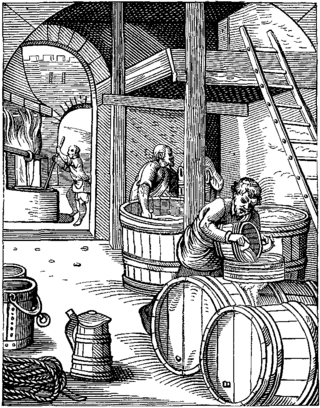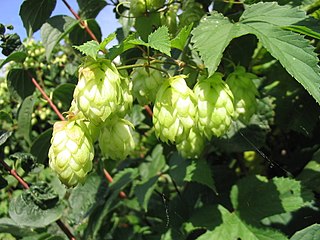
Beer is an alcoholic beverage produced by the brewing and fermentation of starches from cereal grain—most commonly malted barley, although wheat, maize (corn), rice, and oats are also used. The grain is mashed to convert starch in the grain to sugars, which dissolve in water to form wort. Fermentation of the wort by yeast produces ethanol and carbonation in the beer. Beer is one of the oldest alcoholic drinks in the world, the most widely consumed, and the third most popular drink after water and tea. Most modern beer is brewed with hops, which add bitterness and other flavours and act as a natural preservative and stabilising agent. Other flavouring agents, such as gruit, herbs, or fruits, may be included or used instead of hops. In commercial brewing, natural carbonation is often replaced with forced carbonation.

Brewing is the production of beer by steeping a starch source in water and fermenting the resulting sweet liquid with yeast. It may be done in a brewery by a commercial brewer, at home by a homebrewer, or communally. Brewing has taken place since around the 6th millennium BC, and archaeological evidence suggests that emerging civilizations, including ancient Egypt, China, and Mesopotamia, brewed beer. Since the nineteenth century the brewing industry has been part of most western economies.

Hops are the flowers of the hop plant Humulus lupulus, a member of the Cannabaceae family of flowering plants. They are used primarily as a bittering, flavouring, and stability agent in beer, to which, in addition to bitterness, they impart floral, fruity, or citrus flavours and aromas. Hops are also used for various purposes in other beverages and herbal medicine. The hops plants have separate female and male plants, and only female plants are used for commercial production. The hop plant is a vigorous climbing herbaceous perennial, usually trained to grow up strings in a field called a hopfield, hop garden, or hop yard when grown commercially. Many different varieties of hops are grown by farmers around the world, with different types used for particular styles of beer.

Pale ale is a golden to amber coloured beer style brewed with pale malt. The term first appeared in England around 1703 for beers made from malts dried with high-carbon coke, which resulted in a lighter colour than other beers popular at that time. Different brewing practices and hop quantities have resulted in a range of tastes and strengths within the pale ale family. Pale ale is a kind of Ale.

The U.S. state of Oregon is home to more than 200 breweries and brew pubs that produce a large variety of beer.

Sierra Nevada Brewing Co. was established in 1979 by homebrewers Ken Grossman and Paul Camusi in Chico, California, United States. The brewery produced 786,000 US bbl (922,000 hl) in 2010, and as of 2016, Sierra Nevada Brewing is the seventh-largest brewing company in the United States and is the third largest privately owned brewery in the United States.

India pale ale (IPA) is a hoppy beer style within the broader category of pale ale.

In the United States, beer is manufactured in breweries which range in size from industry giants to brew pubs and microbreweries. The United States produced 196 million barrels (23.0 GL) of beer in 2012, and consumes roughly 28 US gallons (110 L) of beer per capita annually. In 2011, the United States was ranked fifteenth in the world in per capita consumption, while total consumption was second only to China.

Humulus lupulus, the common hop or hops, is a species of flowering plant in the hemp family, Cannabaceae. It is a perennial, herbaceous climbing plant which sends up new shoots in early spring and dies back to a cold-hardy rhizome in autumn. It is dioecious and native to West Asia, Europe and North America.

Beer styles differentiate and categorise beers by colour, flavour, strength, ingredients, production method, recipe, history, or origin.

The Lagunitas Brewing Company, founded in 1993 in Petaluma, California, is a subsidiary of Heineken International. Before Heineken bought a 50% share of the company in 2015, the company met the definition of a craft brewery. Two years prior it ranked fifth top-selling craft brewery in the US. Heineken purchased the remainder of the company in 2017.

Beer in the United Kingdom has a long history, and has quite distinct traditions. Historically the main styles were top-fermented Bitters, Porters, Stouts and Milds, but after World War II lagers took over half the market by volume. The Campaign for Real Ale (CAMRA) was founded in 1971 and has encouraged the preservation and revival of traditional styles of ale. In particular CAMRA has promoted cask conditioned beer, which completes its maturation in casks in the cellar of the pub rather than at the brewery. As of 2014 the UK drank 634 million imperial pints of cask ale, representing 60% of ale in pubs and restaurants and 17% of all beer in pubs. In total 42.42 million hectolitres of beer were produced in 2013 of which 48% was sold in the off-trade.

Captain Lawrence Brewing Company is a craft brewery located in Elmsford, New York. The brewery is owned and run by head brewer Scott Vaccaro. Vaccaro, a homebrewer since 1995, trained in brewing science at UC Davis.

A brewery or brewing company is a business that makes and sells beer. The place at which beer is commercially made is either called a brewery or a beerhouse, where distinct sets of brewing equipment are called plant. The commercial brewing of beer has taken place since at least 2500 BC; in ancient Mesopotamia, brewers derived social sanction and divine protection from the goddess Ninkasi. Brewing was initially a cottage industry, with production taking place at home; by the ninth century, monasteries and farms would produce beer on a larger scale, selling the excess; and by the eleventh and twelfth centuries larger, dedicated breweries with eight to ten workers were being built.

Cascade is one of the many cultivars of hops. Cascade hops are one of the most widely used hops by craft breweries in the United States. Cascade was the most widely planted hop by growers in the US for many years, before being surpassed by Citra hops in 2018.

Ale is a style of beer, brewed using a warm fermentation method. In medieval England, the term referred to a drink brewed without hops.

Hemp beer is a form of beer infused with elements of the cannabis plant. Hemp beer is not brewed from hemp directly, but hemp products such as seeds are a later flavoring addition.

The Oregon Hops and Brewing Archives (OHBA), established in 2013, is a community archive in the U.S. dedicated to collecting, preserving, and sharing materials about the story of Northwest hops and brewing.


















